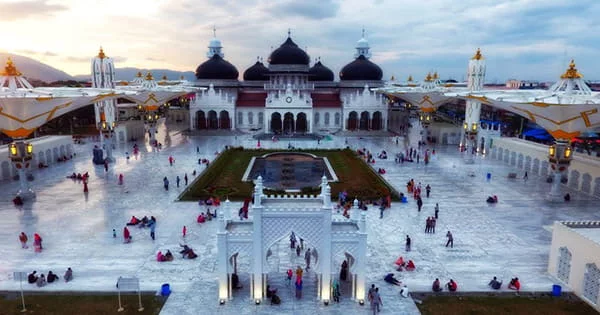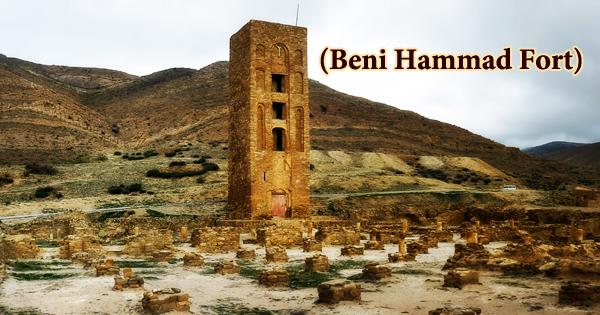Baiturrahman Grand Mosque (Indonesian: Masjid Raya Baiturrahman; Acehnese: Meuseujid Raya Baiturrahman) is one of Southeast Asia’s earliest domed mosques. Perhaps more crucially, the mosque is a physical manifestation of Islam’s political position in Indonesia. The mosque is located in the heart of Banda Aceh, Indonesia’s Aceh Province. The Baiturrahman Grand Mosque is a symbol of the Acehnese people’s religion, culture, spirit, power, struggle, and nationalism. The Dutch built it in 1879 and finished it in 1881 to pacify the Acehnese during the deadly Dutch-led Aceh War. In addition, modifications to the mosque in 1957 were intended to symbolically unite the largely separatist Aceh area to the Republic of Indonesia. This huge mosque, located in the center of Banda Aceh, Nanggroe Aceh Darusallam, has become a symbol of Aceh’s religion, culture, energy, and struggle. When the Tsunami hit Aceh in 2004, the majesty of this mosque was seen, yet it was able to withstand the storm and remain standing. This mosque, located in downtown Banda Aceh, is one of the largest in Southeast Asia. This is the Sultanate of Aceh mosque, which was erected in 1612 under the reign of Sultan Iskandar Muda. Speaking of the catastrophe that occurred in Aceh during the Tsunami, Baiturrahman Grand Mosque became a haven for hundreds of individuals seeking refuge from the Tsunami that wiped out the whole city. Sultan Alaidin Mahmudsyah, according to legend, erected the initial mosque in 1292. The ancient royal mosque had a multi-tiered thatched roof, which is typical of Acehnese design. The Acehnese cherish a particular place in their hearts for Baiturrahman Mosque. It represents Aceh’s incomparably vivid Islamic culture, with its gleaming black-on-white design standing firm against whatever Mother Nature may throw at it. The mosque was spared damage from the earthquake and tsunami, but the 35-meter minaret at the main gate is now slightly skewed and fractured.

With its layers of large hipped meru roofs, this original mosque, known as Mesjid Raya or Grand Mosque, was claimed to mimic a 1614 mosque erected by Sultan Iskandar Muda. When the kingdom of Aceh refused to sign commerce contracts with the Dutch, the Dutch invaded Banda Aceh in 1873, beginning the 30-year Aceh War and demolishing the recently built Mesjid Raya. The Dutch restored the Mosque Baiturrahman in 1879 as a present to the Acehnese and to calm their wrath. Construction began in 1879, when Tengku Qadhi Malikul Adil, the first imam, set the foundation stone and was finished on December 27, 1881, under the reign of Muhammad Daud Syah, the last sultan of Aceh. This 130-year-old great mosque, with its dazzling white façade and splendid black dome, a 35-meter-high tower, enormous seven domes, and seven minarets, is characteristic of an antique and gorgeous edifice ever built in Indonesia. This mosque was initially constructed out of wood in 1621, during the reign of Sultan Iskandar Muda. Others claim that Sultan Alaidin Mahmudsyah erected this mosque even earlier, in 1292. Because Baiturrahman was established by the Dutch, whom they were at war with, many Acehnese first refused to pray there. It is, nonetheless, a source of pride for Banda Aceh nowadays. The mosque had only one dome and one minaret at initially. In 1935, 1958, and 1982, further domes and minarets were erected. The mosque now features seven domes and eight minarets, including Banda Aceh’s tallest. The timber-framed dome, which had never been seen in Acehnese architecture before, was coated in black ironwood shingles, which contrasted with the mosque’s whitish walls, and its hefty wooden towers loomed above the town profile. Moorish accents, such as the tear-shaped arches with parabolic intrados and arabesque plaster moldings, were added to these Mughal components. The mosque, which has enormous domes and minarets, was created by an Italian architect in the North Indian Moghul style. The Baiturrahman is akin to the Dutch and British colonialists’ template for many mosques in Indonesia and Malaysia. The interior has relief-carved walls and pillars, a Chinese marble staircase and floor, stained-glass windows from Belgium, beautiful bronze chandeliers, and well-decorated oak doors. The mosque’s interior area is 4,760 square meters, which can seat 9,000 worshipers at once. The Muslim faithful, on the other hand, have adopted Moghul Revival architecture, which has mostly replaced the traditional tiered-roof mosque. The mosque now features seven domes, eight minarets, and 32 pillars. Minimundus tiny park in Austria has a miniature of Baiturrahman Grand Mosque. Elements of the mosque were gradually added over the twentieth century. Mesjid Baiturrahman, on the other hand, has developed to symbolize Banda Aceh’s crucial religious status as Indonesia’s “eastern entrance to Mecca,” or Serambi Mekah (Mecca’s veranda), as well as an autonomous link between the Acehnese umma and the international Muslim community.
















